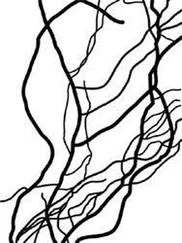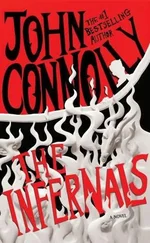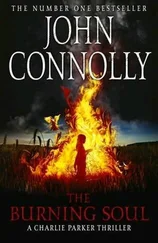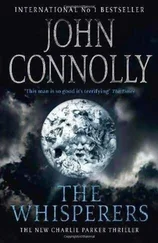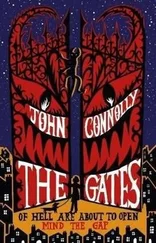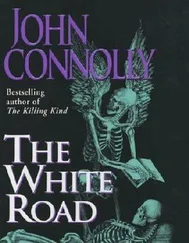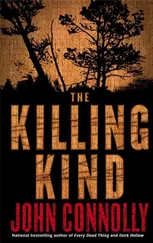Sedlec was now almost a suburb of the larger town of Kutna Hora. A great hill rose up before us: Kank, according to the map, the first big mine opened in the city following the discovery of silver on the Catholic Church’s property. I had seen paintings of the mines in the guidebook. They reminded me of Bosch’s depictions of hell, with men descending beneath the earth dressed in white tunics so that they could be seen in the dim light of their lamps, leather skirts at their backs so that they could slide down the mine shafts quickly without injuring themselves. They carried enough bread for six days, for it took five hours to climb back to the surface, and so the miners stayed underground for most of the week, only coming up on the seventh day to worship, to spend time with their families, and to replenish their supplies before returning to the world beneath the surface once again. Most kept an icon of Saint Barbara, the patron saint of miners, upon their persons, for those who died in the mines did so without benefit of clergy or the speaking of the last rites, and their bodies would probably remain below ground even if they could be found amidst the rubble of a collapse. With Saint Barbara close by them, they believed they would yet find their way to heaven.
And so the town of Kutna Hora still rested on the remains of the mines. Beneath its buildings and streets were mile upon mile of tunnels, and the earth was mingled with the bones of those who had worked and died to bring the silver to the surface. This, I thought, was a fitting place for the interment of the Black Angel: an ancient outpost of a hidden hell in Eastern Europe, a little corner of the honeycomb world.
We hung a right at a big Kaufland supermarket and came to the intersection of Cechova and Starosedlecka Streets. The ossuary was on the latter, directly before us, surrounded by high walls and a cemetery. Across from it was a restaurant and store named U Balanu, and around the corner to the right was a hotel. We asked to take a look at the rooms, eventually finding two that gave us a good view of the ossuary, then went to view the ossuary itself.
Sedlec had never wanted for bodies to fill its graves: what the mines, or plague, or conflict could not provide, the lure of the Holy Land fulfilled. The fourteenth-century Zbraslav Chronicle records that in one year alone, thirty thousand people were buried in the cemetery, a great many of them brought there specifically for the privilege of being buried in soil from the Holy Land, for it was believed that the graveyard held miraculous properties, and that any decedent buried there would decompose within a single day, leaving only preserved white bones behind. When those bones inevitably began to stack up, the cemetery’s keepers built a two-story mortuary containing an ossuary within which the remains might be displayed. If the ossuary served a practical purpose by allowing graves to be emptied of skeletal remains and freed up for those more in need of a dark place in which to shed their mortal burden, it also served a spiritual purpose at least equally well: the bones became reminders of the transience of human existence and the temporary nature of all earthly things. At Sedlec, the border between this world and the next was marked in bone.
Even here, in this foreign place, there were echoes of my own past. I recalled a hotel room in New Orleans, the air outside still and heavy with moisture. We had been closing in on the man who had taken my wife and child from me, and coming at last to some understanding of the nature of his “art.” He too believed in the transience of all human affairs, and he left behind his own memento mori as he traveled the land, tearing skin from flesh, and flesh from bone, to show us that life was but a fleeting, unimportant thing, capable of being taken at will by a being as worthless as himself.
Except that he was wrong, for not all that we tried to achieve was without value, and not every aspect of our lives was unworthy of celebration or remembrance. With each life that he took, the world became a poorer place, its index of possibilities reduced forever, deprived of the potential for art, science, passion, ingenuity, hope, and regret that the unlived existences of generation upon generation of progeny would have brought with them.
But what of the lives that I had taken? Was I not equally culpable, and was that not why there were now so many names, of both good men and bad, carved upon that palimpsest I bore, and for each of which I might justifiably be called to account? I could argue that by committing a smaller evil, I had prevented a greater one from occurring, but I would still bear the mark of that sin upon me, and perhaps be damned for it. Yet, in the end, I could not stand by. There were sins that I had committed out of anger, touched by wrath, and for those I had no doubt that I would at last be charged and found wanting. But the others? I chose to act as I did, believing that the greater evil lay in doing nothing. I have tried to make reparation, in my way.
The problem is that, like cancer, a little corruption of the soul will eventually spread throughout the whole.
The problem is that there are no small evils.
We passed through the cemetery gates and skirted the graves, the more recent stones often marked with photographs of the deceased inset into the marble or granite beneath the word rodina, followed by the family name. One or two even had alcoves carved in the stone, protected by glass, behind which framed portraits of all of those buried beneath the ground sat undisturbed, as they might have done on a sideboard or a shelf when those depicted were still alive. Three steps led down to the ossuary entrance: a pair of plain wooden doors overlooked by a semicircular window. To the right of the entrance, a steeper flight of steps led up to the chapel, for the chapel stood above the ossuary, and from its window, one might look down on the interior of the ossuary itself. Inside the door, a young woman sat behind a glass display case containing cards and trinkets. We paid her thirty Czech koruny each to enter, or barely four dollars between us. We were the only people present, and our breath assumed strange forms in the cold air as we looked upon the wonders of Sedlec.
“My God,” said Angel. “What is this place?”
A stairway led down before us. On the walls at either side, the letters IHS, for Iesus Hominum Salvator, or “Jesus Savior of Humanity,” were set in long bones, surrounded by four sets of three bones representing the arms of a cross. Each arm ended in a single skull. At the base of the stairs, two sets of parallel columns mirrored one another. The columns were made up of skulls alternated with what appeared to be femurs, the bones set vertically beneath the upper jaw of each skull. The columns followed the edges of two alcoves, into which had been set a pair of enormous urns, or perhaps they might have been baptismal fonts, again constructed entirely from human remains and lidded by a circle of skulls.
I stepped into the main area of the ossuary. To my right and left were chambers containing huge pyramids of skulls and bones, too many to count, topped in each case by a wooden crown painted gold. Two similar barred rooms faced me, so that they occupied the four corners of the ossuary. According to the information leaflet thrust into our hands at the door, the remains represented the multitudes facing judgment before God, while the crowns symbolized the kingdom of heaven and the promise of resurrection from the dead. On one of the walls, beside the skull chamber to my right, there was an inscription, again inset in bone. It read:
FRANTIŠEK RINT Z CESKE SKALICE 1870
In common with most artists, Rint had signed his work. But if Bosworth was right, then Rint had seen something while he was completing the reconstruction of the ossuary, and what he had seen had haunted him to such a degree that he had spent years re-creating its image, as though by doing so he might slowly begin to exorcise it from his imagination, and bring himself peace at last.
Читать дальше

